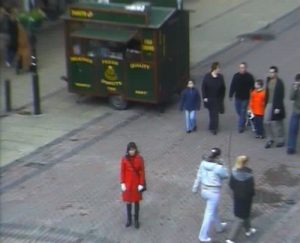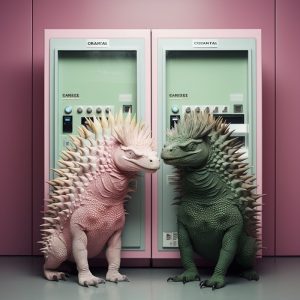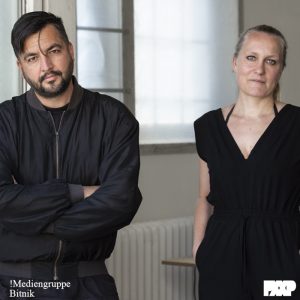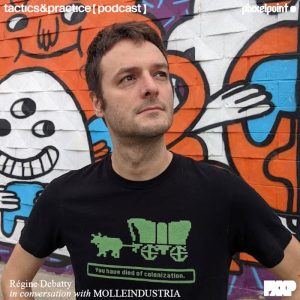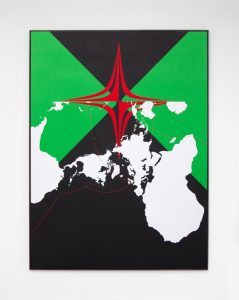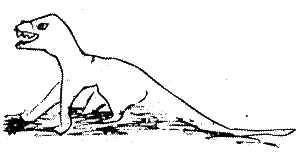The Sonar festival isn’t just music, clubbing and dancing. There were also tons of wmmna-esque works to eyeball at the SonarMática exhibition. Curated by Drew Hemment, José Luis de Vicente, Óscar Abril Ascaso and Advanced Music, the show, called Always On, is the third episode of a series of SonarMatica that focuses on the representation of territory.
The first year of SonarMatica, 2004, had been dedicated to Micronations, last year was called Randonnée and gave a glance through 21st century landscaping, from new figurativism to augmented reality to virtual architecture and datascapes.
This year the exhibition revolved around mobile culture and location projects.
During his talk at the Santa Monica Art Centre on Friday, Jose Luis de Vicente explained the origin of the title Always On. Oscar Abril Ascaso proposed the term “On” because it means “on, activated, switched on” but in catalan it also means “where.” On suggests thus both an idea of place and an idea of activity.
 rnd#06 underworld
rnd#06 underworld
De Vicente added that the idea of urban territory nowadays encompasses also a very crucial, ubiquous yet intangible element: connectivity. He mentionned several books: Hertzian Tales by Anthony Dunne, Design Noir: The Secret Life of Electronic Objects by Anthony Dunne and Fiona Raby and Me++, by William Mitchell and showed the always fascinating work of Richard Fenwick: rnd#06 underworld, a short video that shows a day in any given city: the network of communications and of broadcasts are super-imposed over the city like a veil.
In the past the walls of the city were its more important element, they were a symbol of its cultural and political power. The most powerful element of a city today is its fluid spaces, made of transports (the map of London metro is much more emblematic of the city than any other), electromagnetic waves, radio communications, mobile phone communications, etc. Some cities today define themselves by their tv or radio tower and no longer by their cathedral (cf. Berlin or Shanghai.) The transition from the cathedral to the antenna can sometimes take a very ironic form: the support pole for the golden angel weathervane on Guildford Cathedral in the UK is actually a mobile mast and supports several antennas.
The first ideas of fluid space emerged in the ’60s with Superstudio‘s works and Archigram’s Plug-In City.
The topography of networks doesn’t coincide with the physical topography (cf. Graz’ mobile phone landscape.)
Now back to the exhibition itself, it focusses thus on locative media and the technological and cultural works based on establishing a relationship between information and location.
Some projects were for the first time taking Sonar participants to the streets: i already mentionned Blast Theory’s Day of the Figurines (after three days of constant texting i’m now very poor in phone credit but also missing my figurine, what’s happening to her? wil i be able to get the same in September when Blast Theory will propose the full-fledge version of the game in Berlin?). Other outdoor projects:
– Akitsugu Maebayashi‘s fascinating Sonic Interface. Equipped with a computer in a backpack and headphones, you follow a guide through the city streets, shopping malls, or the underground. The sound you perceive through the headphones reflects the actula urban soundscape but with some suprises: the noises either come in mosaic or they are amplified or repeated. The subject, perceiving a shift between sight and sound finds himself in a new universe and, liberated from unified perception.

 Sonic Interface and Life: A User’s Manual
Sonic Interface and Life: A User’s Manual
– Michelle Teran’s Life: A User’s Manual uses a very common tech device to “hack�? into surveillance cameras and see, what they see, on his/her own screen. As an art performance. Every day at 9 p.m, Michelle Teran was inviting people to follow her on a “sourveillance hacking” tour in Barcelona.
– Counts Media’s famous Yellow Arrow;
– and Geocaching, an outdoor treasure-hunting game in which participants use a GPS receiver or other navigational techniques to hide and seek containers (called “geocaches” or “caches”) anywhere in the world.
Inside the exhibtion:
– Antoni Abad’s beautiful project that allow people with disabilities, prostitutes, gypsies and taxi drivers to broadcast from mobile phones;

 zexe.net and TTSM
zexe.net and TTSM
– Alejandro Duque’s TTSM (Typewriter Tracklog Sewing Machine), by Alejandro Duque, uses a GPS device to track and save the data of a journey without destination. Artist’s links: [k.0]_lab, s.o.u.p.
– Jeremy Wood – “GPS Drawing”- Meridians;
– Jens Brand’s gPod / G-Player;
– a Zapped! kit by Preemptive Media. They were even showing a cockroach with rfid tag on the back. Last year, Preemptive Media had attached reprogrammed RFID tags to the roaches that, if placed in a Wal-Mart store, will taint its RFID database. The group distributed the roaches at the show’s opening, sending them home with gallerygoers in Styrofoam coffee containers.
– Proboscis (UK), Urban Tapestries / Social Tapestries;
 Bio Mapping
Bio Mapping
– Christian Nold’s Bio Mapping which is one of my favourite projects ever! People are sent in the streets with a Bio Mapping tool to record their Galvanic Skin Response, a simple indicator of emotional arousal in conjunction with their geographical location. Using Google Earth, Bio Mapping indicates by the height of each track point the individuals’ physiological arousal at that geographic location.
– Mark Shepard’s Tactical Sound Garden Toolkit;
– Socialfiction’s .walk that raises regimentation to an art form by giving instructions for a walk through a city. These instructions correspond to an algorithm and can be traced back to a simple computer programme;
– The Interpretive Engine for Various Places on Earth, by Jeff Knowlton and Naomi Spellman, is a location-based narrative that relies on Wi-Fi to tell a story specific to user location.
I really enjoyed Always On, the great mix of outdoor and indoor projects, the calm of the exhibition space just below Sonar By Day frenzy, and the focus on a particular theme was so clear that it put the individual projects into a broader perspective. I guess i need to see more shows like that, i’m so used to festivals that showcase the “latest” and the “coolest” or to new media art exhibitions with a very vague theme.

